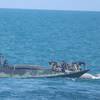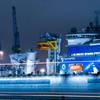The surge in liquefied natural gas (LNG) carrier newbuildings and the accompanying development of a new generation of these specialized ships has generated interest in alternative propulsion systems to the traditional gas fired steam plant. These alternatives are addressed in the new ABS Guide for Propulsion Systems for LNG Carriers, the first such comprehensive set of standards to have been issued by a classification society.
Currently several type of propulsion configurations are being ordered with others yet being planned. At the heart of the differing propulsion systems debate is economics together with safety concerns over the manner in which boil off gas (BOG) is treated.
“There are over 40 ships that have been contracted with propulsion systems other than steam says Mumtaz Mahmood, Director, Technology & Business Development, ABS Europe and primary author of the new guide. “This is a clear indication that gas fired boilers with steam turbines is no longer the most favored choice for the main propulsion plant on standard or large LNG ships.”
Mahmood notes that dual fuel diesel electric and direct drive, slow speed diesel plants, coupled with an on-board re-liquefaction plant to handle the cargo boil off, appear to offer operational efficiencies for these new designs. “However, there is no single obvious propulsion system of choice,” he added. “The choice depends on numerous factors such as gas price or trade route among others.”
The new ABS Guide provides comprehensive criteria for the various propulsion systems currently on offer from shipyards: dual fuel gas turbine/steam turbine combined cycle with electrical propulsion, dual fuel diesel electrical propulsion and slow speed diesel direct drive as well as conventional steam turbines.
In terms of BOG there are two ways it can be handled, explains Mahmood. One is to use it as fuel for propulsion or secondly to re-liquefy and return it back to the tanks. The second alternative requires an on-board re-liquefaction plant. The ABS Guide includes detailed criteria for the plant design, piping, electrical systems, construction materials, compressors, pumps and separators.
Additionally, the document offers guidance with regard to the placement of propulsion systems in the overall vessel arrangement scheme as well as refrigeration systems and redundancy systems required if there is an equipment failure. “Safe BOG utilization and the integrity of propulsion system are two major concerns addressed in the Guide’s design criteria,” says Mahmood.
ABS will offer four different notations for those following the design criteria and construction standards set forth within the guide. They are: RELIQ for re-liquefaction unit design; GCU for gas combustion unit; DFD for dual fuel diesel engine power plant; and DFGT for dual fuel gas turbine power plant.
The release of this publication is the culmination of more than two years of work over which time ABS has directed its team of marine, mechanical and electrical engineers through various iterations while carrying out a series of technical discussions with virtually every manufacturer supplying specialized propulsion and associated equipment to these new breed of LNG carriers. ABS has also hosted and participated in a number of risk studies along with owners, builders and equipment suppliers in order to develop this comprehensive propulsion guidance.
Currently ABS has 35 newbuilding LNG carriers on order. Recent technical initiatives ranging from the LNG carrier vibration analysis to containment and structural strength assessment to setting dual-fuel criteria has further expanded ABS’ acknowledged and long standing leadership in LNG classification.
Featured videos

Tracking Foreign Vessels Working in the U.S. Jones Act Market

Inside the Electrified Truckable Tug

Inmarsat Enhances Service to Drive Digitalization
Subscribe for
Maritime Reporter E-News
Maritime Reporter E-News is the maritime industry's largest circulation and most authoritative ENews Service, delivered to your Email five times per week









